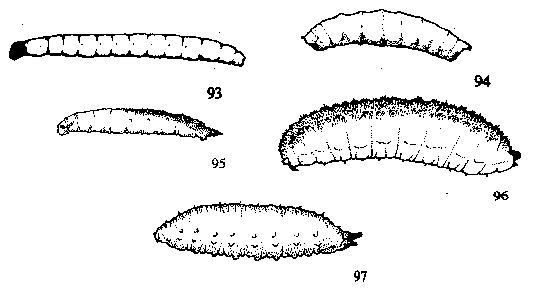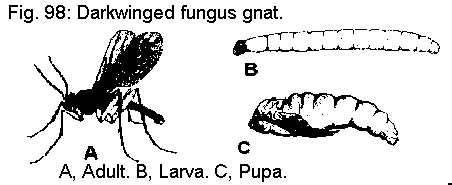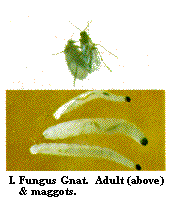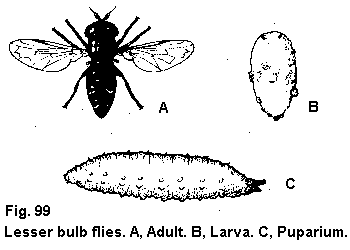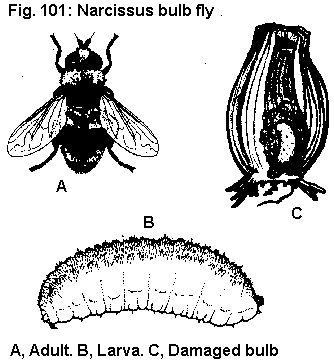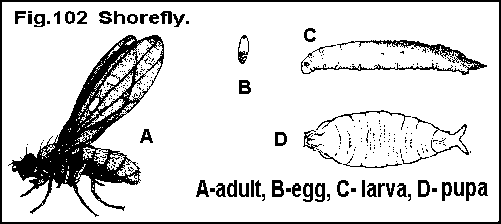Key to Most Common Fly Pests Found on Flowers and Foliage
- Larger flies, 10 to 12 mm long; dense covering of long hairs that gives a furry look, resembling that of bees (Figure 89) - NARCISSUS BULB FLIES
Smaller flies, 6 mm long or shorter; hairs scattered or very short, flies not beelike - GO TO 2 -
Flies about the size of a housefly, 5 to 6 mm long; body shiny under a dense covering of short hairs (Figure 90) - LESSER BULB FLIES
Flies smaller, 3 mm long or less; body either dull colored or with scattered long hairs - GO TO 3 -
Antennae elongate, as long as head and thorax; flies dull black with uniformly dark-colored wings (Figure 91) - DARKWINGED FUGUS GNATS
Antennae no longer than head; pattern usually present on body or wings - GO TO 4 -
Flies shiny black and yellow; wings clear (Figure 92A) - LIRIOMYZA SPP.
Flies dull; some species have patterned body or wings (Figure 92B) - SHORE FLIES
Key to Most Maggots Found on Flowers and Foliage Plants
- Larva with shiny black head capsule; body slender, white, smooth; found in decaying roots or stems or soil around them, rarely even on terminals; mostly in greenhouses (Figure 93) - DARKWINGED FUNGUS GNATS
Without head capsule, with a pair of downward curving mouth hooks; body a typical maggot, wider in middle and tapering to one or both ends, may have roughened skin or fleshy filaments protruding from body - GO TO 2 - Tiny yellow maggots, smooth; mining in leaves of plants (Figure 94) - LIRIOMYZA SPP.
Not yellow and not leafminers - GO TO 3 - Larvae found in roots, rhizomes or bulbs - GO TO 4
Larvae found among algae or on wet surfaces, in hydroponic operations, filters, wet benches, etc. (Figure 95) - SHORE FLIES - Mature larva large, more than 10 mm long; with only 1 pair of very short fleshy filaments under the spiracular tube at end of body; spiracular tube about as long as wide (Figure 96) - NARCISSUS BULB FLIES
Mature larva small, less than 10 mm long; with 3 pairs of fleshy filaments around the spiracular tube; spiracular tube about twice as long as wide (Figure 97) - LESSER BULB FLIES
Fungus Gnat
Darkwinged fungus gnat (Figure 98), Lycoriella spp. and Bradysia spp., Sciaridae, DIPTERA
DESCRIPTION
Adult
The flies are slender with comparatively long legs and antennae. They are grayish-black and about 2.5 mm long.
Egg
The yellowish white tiny eggs are 0.2 mm long and 0.1 mm wide.
Larva
Darkwinged fungus gnat maggots have shiny black head capsules and white bodies (Figure I). The last body segment is lobed and helps push the insect along. Mature larvae are about 5.5 mm long.
Pupa
Initially white; pupae become dark shortly before the adult emerges.
BIOLOGY
Distribution
Darkwinged fungus gnats are found throughout the United States.
Host Plants
Darkwinged fungus gnat maggots feed on the roots of alfalfa, carnations, clover, corn, cucumbers, Easter lilies, geraniums, lettuce, nasturtium, peppers, rape, poinsettias, potatoes, soybeans, wheat, and organic matter.
Damage
Damage first becomes apparent when plants lose their healthy appearance and wilt. Darkwinged fungus gnat adults are usually noticed before injury caused by the maggots is apparent.
Life History
Darkwinged fungus gnat maggots have only recently been recognized as important pests in greenhouses and mushroom cellars. They are also pests of houseplants. Several of these flies are of economic concern. Generally, darkwinged fungus gnats are most abundant in greenhouses in the winter and spring. Adults and larvae inhabit moist, shady areas. Adults live about 1 week, during which time each female deposits 100 to 150 eggs. They are laid in strings of 3 to 40 in the top of the soil, usually near stems of plants. They hatch within 4 days in the greenhouse. There is a tendency for the progeny of each female to be all one sex.
The larvae begin feeding on the root hairs and roots usually in the upper cm of medium, working their way up the plant and into the stem; however, they also feed on any organic matter in the soil. Being somewhat gregarious, the larvae often form clusters in the soil. They mature in about 14 days, after which they construct a pupal case, made of silk and debris, in the soil. The pupal stage lasts about 3.5 days. Adults are weak fliers, but they run rapidly on the soil surface or may remain motionless.
CONTROL
Clean cultural practices and lack of excessive watering usually will prevent fungus gnat infestations. Since fungus gnats prefer potting mixes containing peat moss and abundant moisture, consider using bark mixes and avoid overwatering ornamental plants. Decoy pots of sprouting grain are attractive to females, that lay eggs in these pots. Afterwards, the pots should be submerged in boiling water or the contents destroyed in some manner every 2 weeks to destroy the eggs and maggots. Fungus gnats have few efficient natural enemies. The predaceous nematode, Steinernema bibionis, has reduced fungus gnats in mushroom houses 85 percent when applied at a rate of 600 per m2. Another nematode, Steinernema carpocapsae, is now on the market for fungus gnat control in greenhouses. Some species of fungus gnats in mushroom houses have developed up to 47-fold resistance to a pyrethroid insecticides. For chemical control recommendations, see current state Cooperative Extension publications on ornamental plant pests.
Lesser Bulb Flies
Lesser bulb fly (Figure 99), Eumerus tuberculatus Rondani, Syrphidae, DIPTERA
Lesser bulb fly, Eumerus strigatus Fallen, Syrphidae, DIPTERA
Lesser bulb fly, Eumerus narcissi Smith, Syrphidae, DIPTERA
DESCRIPTION
Adult
Lesser bulb flies are 5 to 9 mm dark blue insects that have a metallic bronze sheen (they appear black at a distance). There are three pairs of grayish white crescents on the abdomen and yellowish hairs at the tip. The thorax has 2 lengthwise pale stripes. The hind legs have wide segments that look as though the legs are adapted for jumping.
Egg
Lesser bulb fly eggs are very small (0.72 by 0.24 mm), slender, and somewhat pointed on one end. They are usually laid in small clusters.
Larva
Maggots of the lesser bulb fly are tiny (0.75 mm) to small (7 to 10 mm) and white to grayish yellow depending on the quality of the host bulb. The larvae are wrinkled and covered with minute spines. They are slightly flattened (2.5 mm wide and 1.8 mm high) and are more slender than those of the narcissus bulb fly. The breathing tube is brick red or brown. There is a fleshy tubercle on either side of the breathing tube (no other maggot pests of bulbs have these tubercles).
Pupa
The pupa develops within the last larval skin, which becomes a tough protective covering about 6 to 8 mm long, 3 mm wide, and 2.8 mm high (the puparium). The puparium is light gray to reddish brown, but when the maggot pupates in the soil, the puparium is completely covered with fine particles of soil.
BIOLOGY
Distribution
Lesser bulb flies were introduced into the United States from Europe. These flies occur wherever narcissus are grown.
Host Plants
Lesser bulb flies are sometimes damaging to onion, narcissus, and hyacinth. Other hosts include shallots, garlic, iris, lilies, parsnips, potato tubers, amaryllis, cabbage roots, Calla elliottiana, Eurycies, Galtonia, Gladiolus, Scilla, Sprekelia formosissima, and vallota.
Damage
Up to 25 percent of some varieties of narcissus and 10 percent of hyacinths have been infested by lesser bulb flies in some landscapes. The maggots scrape away the bulb tissue and tunnel in. The infested bulbs begin to decay and the interior of the bulb fills with a semiliquid mass. The bulb may be killed completely, or damaged to the point that only stunted leaves appear the following year.
Life History
The winter is spent as maggots in the bulbs. In spring, the maggots migrate toward the soil surface and pupate. The first generation of flies emerges in April and May. These flies live about 3 weeks. The second generation emerges in midsummer, and a small third generation emerges in late summer. Female lesser bulb flies crawl down into cracks in the soil and lay eggs near, on or under the dead skin covering the bulbs. Some eggs are laid on the leaves at the neck of the bulbs and some are laid on the soil surface. Females lay their eggs singly or in small masses of 2 to 40. More than 100 eggs have been found around one bulb. The eggs hatch in 5 to 10 days. Newly hatched maggots emerge from the pointed end of the egg. Ten to 30 maggots may develop in a bulb (947 is the maximum number recorded from a single bulb). The tiny maggots usually attack the base of the bulb although sometimes only the upper portion of the bulb is infested. Infested bulbs begin to decay and the interior of the bulb fills with a semiliquid mass. Although the maggots can successfully attack a healthy bulb, the maggots cannot complete their envelopment in the absence of certain decay organisms. Bulbs infested with stem nematodes (Tylenchus dipsaci Kuehn) or infected with a root rot fungus are especially vulnerable to attack. After about 30 days, the maggots mature and some of them crawl to the surface where they pupate inside the last larval skin. One to 4 weeks later, adult flies emerge from the puparia. If a source of nectar is available and temperatures are not extreme, some of the lesser bulb flies may live up to 36 days.
CONTROL
If the narcissus are planted as winter annuals and the bulb discarded after blooming in the spring, there will be no problem with lesser bulb fly maggot damage as the flies oviposit only during the warm growing season. If the bulbs are left in the landscape semiperminantly and only lifted every three or four years, then injury caused by the lesser bulb fly may become excessive if the flies are active in the neighborhood. Because of the extended flight period of the lesser bulb fly, it may be necessary to resort to the application of pesticides in neighborhoods in which the flies are active. Over-planting beds of narcissus with summer annuals may greatly reduce lesser bulb fly damage. Tilling the soil destroys the holes left by the dying narcissus leaves that the flies often use to reach the bulbs. Many of the tiny maggots may perish before they can reach the bulbs.
When digging, all bulbs should be removed. Soft, decaying bulbs should be destroyed. Bulbs in marginal condition can be treated in hot water (43 to 44°C) for 3 hours to control lesser bulb flies as well as stem nematodes.
Liriomyza Trifolii Fly
Liriomyza trifolii (Burgess) (Figure 100), no common name, Agromyzidae, DIPTERA
DESCRIPTION
Adult
The small fly, about 2.5 mm long, is dark gray with yellow markings (Figure N).
Egg
The tiny, whitish egg is deposited in the leaf.
Larva
The legless, whitish to yellow larva grows to about 2 mm long, with a darker head and a mouthhook structure that is retractable into the body.
Pupa
The pupa, formed within the old skin of the last larva (puparium), is yellowish brown.
BIOLOGY
Distribution
Presently, Liriomyza trifolii occurs primarily in Florida and California, and is found rarely in greenhouses along the eastern United States to Maryland. It is also found in Central America.
Host Plants
Liriomyza trifolii has been found on many plants. Some of the hosts are aster, dahlia, marigold, chrysanthemum, sunflower, zinnia, baby's breath, mistflower, petunia, daisy, eggplant, celery, carrot, potato, beans, garden peas, cantaloupe, lettuce, cucumber, and garden onion.
Damage
Large populations of these flies destroy leaves and seriously retard growth of young plants (Figure N). The presence of the larval mines reduces the commercial value of ornamental plants and cut flowers.
Life History
Liriomyza trifolii is one of a few leafmining flies that are truly polyphagous. It feeds on many economically important plants and can be a destructive leaf miner of chrysanthemums, gerbera daisies, Gypsophila, tomatoes, celery, and other vegetables.
Liriomyza trifolii breeds throughout the year in southern Florida, but it has only 3 to 4 complete generations in its more northerly range. The first generation appears in April, and the egg stage lasts only 2 days. In the leaves, the larvae form linear mines, if space is available, confining frass to the sides in regular, alternate strips. If leaves are very small, the larvae form blotch mines. There are three larval stages each requiring 7 to 8 days to develop. Pupation occurs within the leaf and lasts 7 to 11 days, depending upon the time of the year. Adults live 3 or 4 weeks. Partial generations occur in the winter when the reproductive activities of the insects decrease. The flies can be found in greenhouses year-round.
CONTROL
Liriomyza trifolii can develop and emerge successfully from infested leaves that are detached and drop to the bench top or greenhouse flower, particularly if the relative humidity remains high. It is important to remove infested plant debris from the greenhouse to impede the populations of Liriomyza trifolii. At one time Liriomyza trifolii was a very difficult insect to control because it is highly resistant to many organophospate, carbamate, and pyrethroid insecticides. With the introduction of cyromazine and abamectin for leafminer management, the incidence of Liriomyza trifolii decreased dramatically.
For specific chemical control recommendations, see your state Cooperative Extension publications on ornamental plant pest management.
Narcissus Bulb Fly
Narcissus bulb fly (Figure 101), Merodon equestris (Fabricius), Syrphidae, DIPTERA
DESCRIPTION
Adult
Narcissus bulb flies are 9 to 12 mm flies that resemble bumble bees although some individual flies are more reddish brown, orange, or tan than the species of bumble bees that occur in the southeastern United States. Unlike bumble bees, narcissus bulb flies have a very rapid flight and also tend to hover in flight. Narcissus bulb flies also show a marked preference for narcissus plants whereas bumble bees usually forage on flowers.
Egg
Narcissus bulb fly eggs are white and slender and about 1.5 mm long. They usually occur on the host plant leaves close to the soil.
Larva
Newly hatched maggots are about 1 mm long. Third stage maggots are about 19 mm long and are a dirty tan. The maggot is plump and slightly arched. The skin is tough and wrinkled. The mouth hooks and breathing tube are almost black.
Pupa
The pupa occurs in the last larval skin. The skin becomes a tough, brown, 13 by 7 mm case (puparium) inside of which the relatively delicate pupa develops.
BIOLOGY
Distribution
The narcissus bulb fly occurs wherever narcissus are grown throughout the United States. This pest was introduced from Europe in about 1869.
Host Plants
The narcissus bulb fly has been reported to infest amaryllis, daffodil, Galtonia, Flanthus, hyacinth, Iris, lilies, Leucofum, Narcissus, Scilla, tulips, and Vallota.
Damage
The center of the bulb is hollowed out and the flower bud is destroyed. Many infested bulbs rot away although some survive to send up a few scrawny grasslike blades the following year.
Life History
Narcissus bulb flies now occur throughout the world wherever narcissus are grown. In the United States, narcissus had been virtually pest free here until the fly was introduced. Narcissus bulb flies emerge from the soil usually in May. After mating, females lay one to three eggs between the sheath and stem of each bulb or between the layers of skin enclosing the neck of the bulb. Females lay from 40 to 100 eggs each. Ten days to 2 weeks later the eggs hatch and the tiny maggots bore down through the outer bulb scales to the basal plate where they tunnel extensively for some time. Later they bore directly inside the bulb. The maggots develop rapidly in the next two months and become virtually fully grown, although they do not pupate until the following spring. Usually only one maggot develops per bulb although more are occasionally found. Five to 7 weeks are spent in the pupal stage before a new generation of adults emerges. There is one generation per year although some individuals require 2 years to mature.
CONTROL
Control of the narcissus bulb fly is not easy. The insect has few natural enemies. Cultural controls include mowing the leaves as soon as they dry in late spring and then cultivating the soil lightly to prevent the females from finding the holes left by the leaves. Lifting the bulbs as soon as the tops die back and then sorting out and destroying infested bulbs should also help to decrease the population for the following year. Catching the flies in an insect net and destroying them should also help to decrease the population (each female destroyed means 100 potential maggots are destroyed).
A hot water bath has also been found to be effective in killing maggots in infested bulbs. Maggots can be killed if bulbs are submerged in water kept at about 43 to 44°C for 40 minutes. Care must be taken to avoid overheating the bulbs even for a short time as the bulbs may be adversely affected by high temperatures. For chemical control, drench a mixture of insecticides and water in early May. For specific chemical control recommendations, see your state Cooperative Extension publications on ornamental plant pest management.
Shore Fly
Shore fly (Figure 102), Scatella stagnalis (Fallen) and perhaps other spp., Ephydridae, DIPTERA
DESCRIPTION
Adult
Shore flies in the genus Scatella are small (2 mm) black flies with reddish eyes and gray wings with clear spots. Shore flies resemble eye gnats, fruit flies, or vinegar flies in general shape. Shore flies are sometimes confused with darkwinged fungus gnats which are about the same size and color. (Darkwinged fungus gnats are shaped more like miniature mosquitoes and have relatively long legs and 50 antennae.)
Egg
Shore fly eggs are about 0.42 long and 0.2 mm wide. They are fairly rounded at both ends although there are small lobes on one end. The surface of the egg is covered with minute, faint polygons. The eggs remain white throughout the development of the embryo.
Larva
The tiny first stage maggots have two spiracles only at the rear. The next two larval stages have two spiracles on the rear and a spiracle on either side near the head. The mature maggot is about 2.6 mm long and 0.9 mm wide and 0.5 mm high. The hind spiracles are black and are located at the end of small but conspicuous tubes. The anterior spiracles each resemble the fingers of a slightly inflated rubber glove but these spiracles are microscopic and inconspicuous.
Puparium
The puparia of Scatella shore flies are brown to dark brown, curved, and tapered on both ends. The puparia are about 2.6 mm long and 0.9 mm wide. At the hind end, the spiracles resemble stiff antennae. On the front, the anterior spiracles stick out sideways like microscopic horns. The puparia are curved toward the top side of the developing fly.
BIOLOGY
Distribution
Shore flies in the genus Scatella are found throughout the United States, Canada and northern Mexico.
Scatella stagnalis also occurs widely in Europe and Asia. Most species naturally occur on muddy or marshy lake shores and intertidal zones of beaches.
Food Plants
Adult and immature shore flies feed on microscopic algae, dinoflagellates, bacteria, cyanobacteria, and other unicellular forms.
Damage
Neither adult nor immature shore flies feed upon ornamental plants. The damage caused by shore flies consists primarily in the excrement ("fly specks") left on the foliage of bedding plants and other ornamentals. Because shore flies are often confused with darkwinged fungus gnats, control efforts are often wasted (darkwinged fungus gnats may be harmful to plants but are relatively easy to control; shore flies are harmless but are very difficult to control with insecticides). Sometimes shore flies become so abundant in greenhouses that the sheer numbers of flies becomes a deterrent to customers browsing or even employees working.
Life History
Scatella shore flies are commonly found in greenhouses where they breed in algae growing on the potting mix, pots, benches and floors. Females scatter eggs right on the surface of the potting mix. The eggs hatch in 2 to 3 days. The larvae are found within the crust of algae and very top layer of potting mix. The maggots feed on bacteria and yeasts as well as diatoms and flagellates growing on the surface of the potting mix. The larvae mature in 3 to 6 days and pupate inside the skin of the last larval stage (this kind of pupa is called a puparium). The last larval skin affords the relatively tender and completely helpless pupa protection from environmental hazards (including insecticides). Some of the puparia are found on top of the potting mix or are very close to the surface. A new generation of adult flies emerges 4 to 5 days later. The adults crawl about on the surface of the potting mix, on the plants or they fly about the pots and plants. The flies move and fly rapidly but generally stay close to their breeding sites. The adults feed primarily on diatoms and flagellates on the surface of the potting mix or mats.
CONTROL
Perhaps because of the high biological activity of the surface of the potting mix, the protection afforded the pupa by the last larval skin, and the water repellent property of the adults, insecticides do not seem to readily suppress shore flies in greenhouses. Cultural methods of shore fly management include avoiding excessive use of water during irrigation, using the minimal optimum levels of fertilizers for adequate plant growth (and lower levels of excess fertilizers that encourage algal blooms), and a drier greenhouse environment. Algae on mats, benches, the walls or other structural members, and the soil beneath benches should be eliminated by using an approved algicide. Because shore fly maggots can also develop on rotting vegetable matter, general greenhouse sanitation should also help suppress shore fly numbers. For specific chemical recommendations see your state Cooperative Extension publications on ornamental plant pest management.
Publication date: Jan. 1, 1994
AG-136
Other Publications in Insect and Related Pests of Flowers and Foliage Plants
- Aphids Found on Flowers and Foliage
- Beetles Found on Flowers and Foliage
- Bugs Found on Flowers and Foliage
- Caterpillars Found on Flowers and Foliage
- Flies and Maggots Found on Flowers and Foliage
- Leafhoppers Found on Flowers and Foliage
- Mealybugs Found on Flowers and Foliage
- Mites Found on Flowers and Foliage
- Scale Insects Found on Flowers and Foliage
- Slugs and Snails Found on Flowers and Foliage
- Thrips Found on Flowers and Foliage
- Whiteflies Found on Flowers and Foliage
N.C. Cooperative Extension prohibits discrimination and harassment regardless of age, color, disability, family and marital status, gender identity, national origin, political beliefs, race, religion, sex (including pregnancy), sexual orientation and veteran status.



